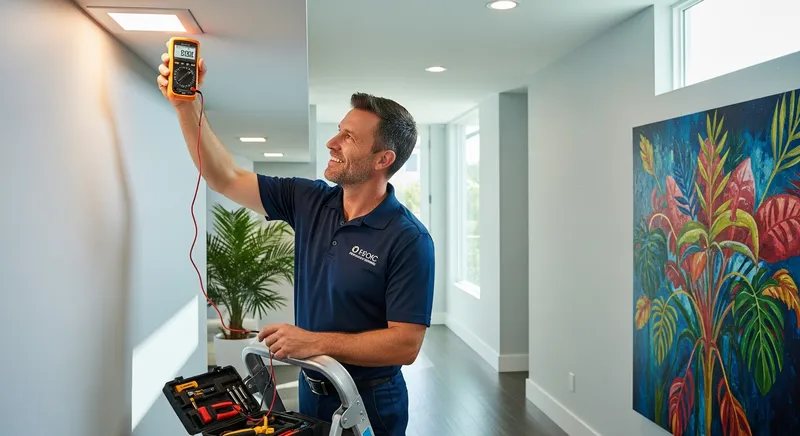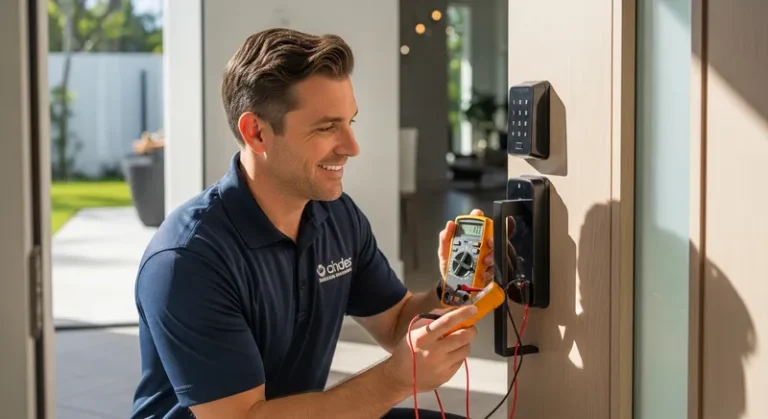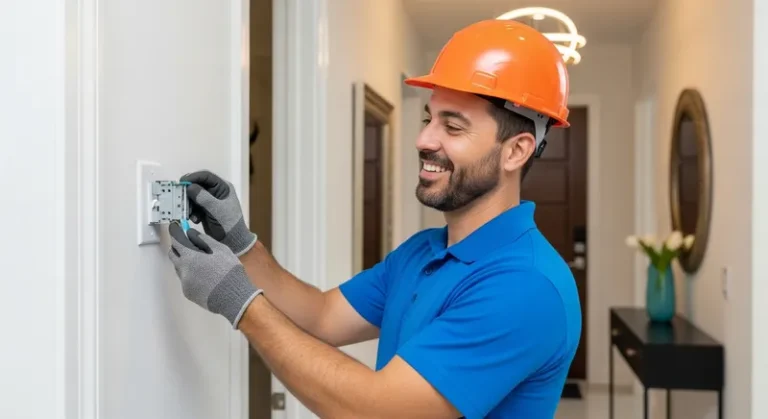Fixing Smart Lighting Problems
To fix smart lighting problems, address common connectivity issues by placing your router centrally and ensuring your devices are on the same frequency. If apps are unresponsive, check the Wi-Fi network, update the app, or reinstall it if needed. Dim or flickering lights can often be resolved by tightening wires or adjusting dimmer settings. For color inconsistencies, calibrate lights and match lumens. Improve your setup by managing Wi-Fi overload and discover more troubleshooting tips ahead.
Key Takeaways
- Ensure your smart lighting system is connected to the same Wi-Fi frequency band for optimal performance and stability.
- Check for app updates and permissions, and restart your device and app to resolve unresponsive issues.
- Adjust dimmer settings for compatibility and check for loose wires or faulty bulbs to fix dim or flickering lights.
- Perform color calibration and ensure all bulbs have the same lumen output to address color and brightness inconsistencies.
- Use Wi-Fi extenders and prioritize network settings to manage overloaded networks and enhance smart lighting responsiveness.

Common Connectivity Issues
When setting up smart lighting systems, you may encounter several common connectivity issues that can disrupt performance and user experience.
One major factor is network interference, which can stem from competing devices on the same frequency. This interference weakens the signal strength, making it difficult for your smart lights to maintain a stable connection.
Walls, appliances, and even other wireless devices can contribute to this problem. To mitigate these issues, try relocating your router to a more central position, away from obstructions.
Additionally, guarantee your smart lighting system is on the same frequency band as your Wi-Fi network.
Troubleshooting Unresponsive Apps
Network connectivity issues can affect not only the performance of your smart lights but also the apps that control them.
If your app is unresponsive, start by ensuring your device is connected to the right Wi-Fi network. Next, check for app updates; outdated software can lead to glitches. Updating the app often resolves these issues.
Additionally, review user permissions; your app may require specific access to function properly. If permissions are denied, the app mightn’t operate as expected.
Restart your device and the app to clear temporary issues. If problems persist, consider uninstalling and reinstalling the app, which often resolves deeper issues.
Fixing Dim or Flickering Lights
If you’ve noticed your smart lights dimming or flickering, it’s crucial to address the issue promptly to maintain peak performance.
Start by checking your dimmer settings. Incompatible dimmer switches can cause flickering due to mismatched technology. Verify your smart lights are compatible with your existing dimmers.
Next, examine the flicker frequency; rapid flickering typically indicates a problem with the power source or connection. Tighten loose wires and replace faulty bulbs to mitigate this issue.
Additionally, consider adjusting the dimmer settings within your smart app to see if it resolves the flickering.
If problems persist, you may need to upgrade your dimmer or consult a professional to guarantee optimal functionality and safety for your smart lighting system.
Addressing Color and Brightness Inconsistencies
To achieve a consistent and vibrant lighting experience, it’s essential to address any color and brightness inconsistencies in your smart lighting system.
Start with color calibration; use a color meter to measure the output of your lights. Compare these readings to a standard reference and adjust your smart bulbs accordingly. Most smart lighting apps offer built-in calibration tools that simplify this process.
Next, focus on brightness adjustment. Verify that all bulbs are set to the same lumen output, as variations can create an uneven environment. You can manually adjust each bulb’s brightness or utilize the app’s group control feature for a unified setting.
Following these steps will enhance the overall aesthetic and functionality of your smart lighting setup.
Resolving Compatibility Problems With Other Devices
While smart lighting offers enhanced convenience and control, compatibility issues with other devices can hinder your overall experience. To guarantee seamless device integration, regularly check for firmware updates for both your smart lights and other connected devices. Here’s a quick reference table to help you troubleshoot common compatibility issues:
| Issue | Possible Cause | Solution |
|---|---|---|
| Smart bulb not responding | Outdated firmware | Perform firmware updates |
| Inconsistent control | Device incompatible | Check compatibility list |
| App crashes | Software conflicts | Reinstall or update apps |
| Connectivity issues | Weak Wi-Fi signal | Improve signal strength |
Managing Overloaded Wi-Fi Networks
As smart lighting systems rely heavily on stable Wi-Fi connections, managing overloaded networks becomes essential for maintaining ideal performance.
To guarantee your smart lights operate smoothly, consider using Wi-Fi extenders to broaden your network’s reach. These devices can help eliminate dead zones, allowing your lights to stay connected without interruption.
Additionally, implement network prioritization in your router settings. By designating bandwidth to your smart lighting system, you minimize latency and enhance responsiveness.
Regularly monitoring your network can also reveal devices consuming excessive bandwidth, enabling you to take necessary actions.
Enhancing Your Smart Lighting Setup for Better Performance
After ensuring your Wi-Fi network is optimized for smart lighting, you can take further steps to enhance the overall performance of your setup.
Start by considering smart bulb placement; position bulbs to maximize coverage and minimize interference. Avoid placing them near electronic devices that could disrupt the signal.
Next, utilize energy-efficient bulbs that offer lower wattage without sacrificing brightness. This not only reduces energy costs but also extends the lifespan of your bulbs.
Additionally, adjust the brightness levels based on the time of day or activity, which helps maintain energy efficiency.
Regularly update your smart lighting firmware to benefit from performance enhancements and new features, ensuring your system runs smoothly and effectively in your home.
About Us
We understand that electrical issues can be stressful and overwhelming. That’s why we are here to lend a helping hand and provide you with the best electrical services in town. As a team of experienced electricians, we take pride in our ability to solve any electrical problem with precision and care.
Pages
Follow us
© 2025 By Electrician Fort Lauderdale Today





